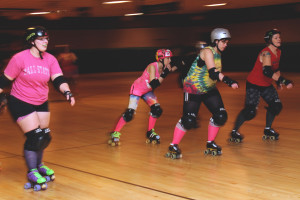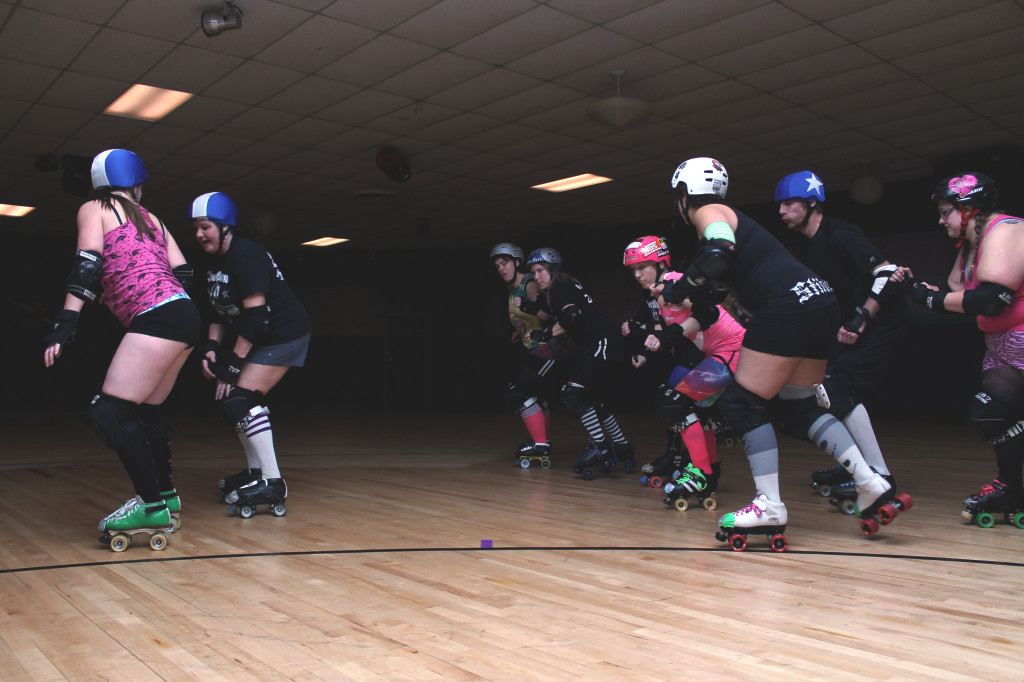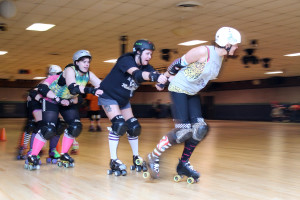 By day they are nurses, kindergarten teachers, mothers and professors. By night they go by a different name, pick up their skates, wear their fishnets and begin jamming.
By day they are nurses, kindergarten teachers, mothers and professors. By night they go by a different name, pick up their skates, wear their fishnets and begin jamming.
Rachael Smith, East Central Roller Derby league owner, began competing in roller derby in 2008. A friend invited her to a derby boot camp in Indianapolis. She had a blast. It was, however, a Women’s Flat Track Derby Association league comprised of many rules.
Smith didn’t like playing by the WFTA rules, so she started the only renegade league in Indiana: ECRD, located in Anderson, Ind.
“I wanted to do something that was empowering and something that was fun,” Smith said. “Women very rarely get to participate in aggressive sports, and this is one of those sports that you could be aggressive.”
The renegade league structures the sport similar to other leagues. They have two 30-minute periods within a bout in which the jammers try to get as many points as possible.
The difference: A renegade league doesn’t have any rules.
Penny Zellers, known in the rink as Felony Con-Vixen, began competing in roller derby 4-years ago when she was handed an ECRD flyer.
Although the structure is similar to other sports, ECRDs style is different.
“Basically anything goes as long as it’s in the safety guidelines,” Zellers said.
At first Smith didn’t know if the league was going to succeed.
“I didn’t know if Anderson was ready for roller derby,” Smith said.
Eventually more girls came to skate, men came to referee and volunteers helped the bout run smoothly. At one point, there were over 80 skaters.
They now have five teams: Vicious Vixins, Bashing Bombshells, Damaging Damsels, Manic Misfits and a travel team comprised of the best players from each team. The teams practice twice a week, each player has to practice six times a month in order to bout.
Their boot camp takes place at the end of July, and their bouts are open from September to April, and their travel team plays throughout the summer.
The main quality a derby girl must have is commitment, according to Smith. Commitment can’t be taught.
“I’ve had girls come out that have never skated,” she said. “And then they’re hitting people like champs.”
Zellers, co-captain of the Vicious Vixins and the secretary for their decision-making board, was one of those women. “They taught me everything. Because, at first, I couldn’t stand up and skate around the rink by myself,” she said.
The skills weren’t difficult for Zellers to learn, she said. Since becoming a derby girl Zellers, has lost 45 pounds without changing her diet. She says the workouts are that intense.
 The women currently skate on an oval, wooden skating rink, but derby can be played on any surface where an oval shape can be created and the wheels on their blades will turn.
The women currently skate on an oval, wooden skating rink, but derby can be played on any surface where an oval shape can be created and the wheels on their blades will turn.
In order to ensure the skater’s safety, the elected disciplinary committee for the no rules league creates guidelines. The skaters aren’t allowed to purposely trip or punch other skaters. If the players go against the guidelines, the disciplinary committee decides their punishment. This can range from sitting out a bout to volunteering within their community.
Nearly all roller derby leagues and teams volunteer within their communities. For example, ECRD will soon be hosting a skate where all proceeds will go to Alternatives Inc., a shelter for battered women and children.
“Most people think that derby is just about a bunch of girls in fishnets hitting the crap out of each other. And that’s not the case,” Smith says. “It’s so much more than that. It’s helping the community and the individual. It’s learning and growing as a group of people.”
For Zellers, roller derby isn’t only a way to get involved, but it’s an outlet for her to relieve stress.
“It’s the cheapest therapy I’ve ever found,” she said.
ECRD teams only play other renegade teams, and since they’re the only one in Indiana, they have to travel to compete. This costs money, so they fundraise in many ways: car washes, pool tournaments, ticket and merchandise sales and skater dues.
Zellers said there isn’t a thing she doesn’t like about the sport. They don’t skate just to hit and fight people.
“I think [roller derby] got into my blood honestly; I don’t know what I’d do without it at this point,” Zellers says. “They’re my second family basically. It’s not always smooth sailing there, but I always come back because I love the sport. I love the competition. I love the people.”
[[accordion close=”1″ title=”DERBY DICTIONARY”]Blocker
A skater whose job it is to stop or block the other team’s jammer from passing while helping her team score
Bout
One roller derby per game
Grand slam
When a jammer succeeds at lapping the other team’s jumper
Jam
A two-minute period where the scoring occurs
There can be any number of jams within a bout.
This is similar to a quarter in a basketball game.
Jammer
The skater on the track who scores all the points with the star on her helmet
Lead jammer
The first jammer to emerge cleanly from the group is designated the lead jammer by the referee.
Pivot
The blocker who stays in the front of the of the group regulating the group’s speed[/accordion]]




